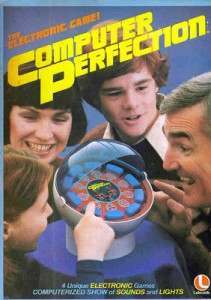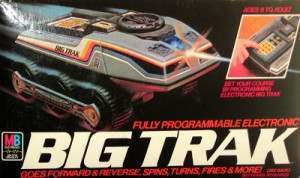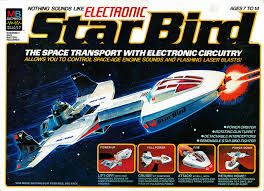Today, we have iPhone apps and video game consoles…and thank goodness for them.
But when I was a kid in the l970s — a long, long time ago — the home video game market was only in its infancy, and another kind of toy ruled the market instead: the “electronic” toy.
This was the era of Quiz Whiz, Simon, BLIP, and the first Electronic Battleship (1977). These and other electronic toys seemed incredibly futuristic at the time with their light-up indicators, keypads, and buzzing sound effects.
Today, of course — over three decades later — these toys would hardly pass muster with any eight year old.
And yet the following five electronic toys I still remember with incredible fondness. Indeed, they all have prominent real-estate in my home office to this day.
5. MERLIN
Okay, so to kids raised today, this little hand-held toy from Parker Bros. seems pretty lame, I readily admit. But back in 1978 — when I was eight going on nine — MERLIN was awesome. More than that, it was representative a revolution in hand-held toys.
MERLIN is a red hand-held device with three distinct sections. The top is the speaker for the “computer vocabulary,” the middle is the keyboard: the eleven notes you can tap in each game. And the bottom section is the game selection, re-start functionality board. Options here are “New Game,” “Same Game” “Hit Me” and “Comp Turn.” Looking at the toy, it resembles the tricorder from Star Trek: The Next Generation (which came along in 1987).
The box asked: “Can you outsmart MERLIN? He’s remarkably intelligent. With lights, a powerful computer brain and a vocabulary of 20 different sounds he challenges you to beat him at these six games of strategy, memory and skill.”
The box then goes on to list the games MERLIN plays, which include Tic-Tac-Toe, Music Machine, Echo, Blackjack 13, and Magic Square. Yes, today we have telephones with advanced apps that do all this, and a whole lot more.
4. Intercept
This electronic game, Intercept, from Lakeside was also called “the electronic search and destroy game,” and the box front trumpets that it comes with “the sounds and lights of fighter attack.”
Yep, Intercept is a Cold War era game that allows you to “be the attack pilot” or “be the defense commander.” That means you can play either side in the nuclear Armageddon with the Soviet Union.
As the attack pilot, you are tested in this way (according to the box): “Can you sneak past your opponent’s surface-to-air missile sites and attack his Airfield?
As the Defense Commander, you are tasked in this fashion: “Can you track down and destroy the Attack Jet? Use your logic to pin-point his position. Fire your rockets to score a direct hit.”
The coolest piece on the board is a crimson-colored “Interceptor Defense Command” Or as the box describes it: “This Special Aircraft, when placed on Target, ELECTRONICALLY locks on to the Attack Jet. It will program your rocket Fire and score a direct hit as the Attack Jet flares up on the tracking grid.”
Every kid of the 1970s should have had Intercept, so he or she could practice starting World War III….
3. Computer Perfection
Fans of sci-fi TV might remember Computer Perfection (The Electronic Game!) because it appeared in a few genre sci-fi series in the 1970s and early 1980s as a “futuristic” prop. Check out the second season episode of Buck Rogers in the 25th Century titled “Mark of the Saurian.” There, Buck (Gil Gerard) is sick with a fever and at his bedside in the Searcher’s sick bay is –you guessed it — Computer Perfection.
Anyway, Computer Perfection, like the other toys on this list is a primitive game system by today’s lofty standards. The transparent blue dome acts as “an on/off switch,” according to the instructions. Once you lift the blue dome, you can select from four games, and choose from three skill levels
Game One is “Countdown” (a one-player scenario), in which the object is “to light all 10 lights in the proper order, in the least number of moves” (or presses of the blue game buttons).
Game Two is “Black Hole” (also for one player). The object of Black Hole is the same as Countdown, lighting all the lights in the proper order. The difference: if “you press a button already lit, the computer will turn off all the lights that are ahead of that light, plus the light itself.” Got it?
Game Three is “Brain Battle.” This is a two player game. The player on the left must turn off all the lights starting with number one; the second player must turn all lights on, starting with number six.
All right, now I’m confused…
Game Four is “Light Race” in which the object is a “Race” to turn on more than five lights. It is also for two players.
On the back of the box, the game also addresses the player. “GREETINGS, I am COMPUTER PERFECTION,” it states, “the ultimate playmate. Probe my memory to discover the electronic clues that will light my lights in the proper order. Do it as quick as you can and I will keep score. Take too long – I will turn you off. Choose a new game every time or ask me to repeat your last game to improve your score.”
2. Big Trak
On the cusp of the futuristic 1980s (!), Milton Bradley’s electronic toys seemed truly amazing and forward-looking. MB created Big Trak, the “fully programmable electronic” vehicle.
Big Trak is a big, land rover-type vehicle. The craft is sleek and it looks bad-ass. On the dorsal side of the tank is a rectangular computer panel or keypad, fully programmable. As the box establishes:
BIG TRAK’s computerized Control Center — with its intricate electronic memory — can accept complex programs of up to 16 separate commands. Big Trak can go out of the room and return to you; it can maneuver around furniture. Detailed instruction booklet (with sample programs) included.”
So Big Trak could “respond to your commands” and the box invites kids to “watch Big Trak perform! Goes forward and reverse, turns, spins, and fires.”
1. Star Bird, Star Bird Avenger
This is one of my absolute favorite childhood toys. Also from Milton Bradley, this electronic spaceship was part of a toy line that included an enemy ship (The Intruder), and a giant headquarters, or Command Base.
The ship was originally called “Star Bird” but later renamed Star Bird, Avenger, suggesting that Star Bird was a class of ships, and Avenger the specific vehicle.
The Star Bird could also be disassembled and recreated in the form of a scout craft. But even cooler than that: this star cruiser featured forward-mounted lasers that would light up red and make a blasting sound. If you had the enemy ship, the toys were interactive, and each ship could blast the other, resulting in sounds of damage.
Also, the electronics changed depending on the pitch of the Star Bird. If the ship was pointed upwards, or climbing, the engine “pull” sound increased in intensity, and the engines made a different sound when the ship was positioned for descent.
Would you like to support Flashbak?
Please consider making a donation to our site. We don't want to rely on ads to bring you the best of visual culture. You can also support us by signing up to our Mailing List. And you can also follow us on Facebook, Instagram and Twitter. For great art and culture delivered to your door, visit our shop.








